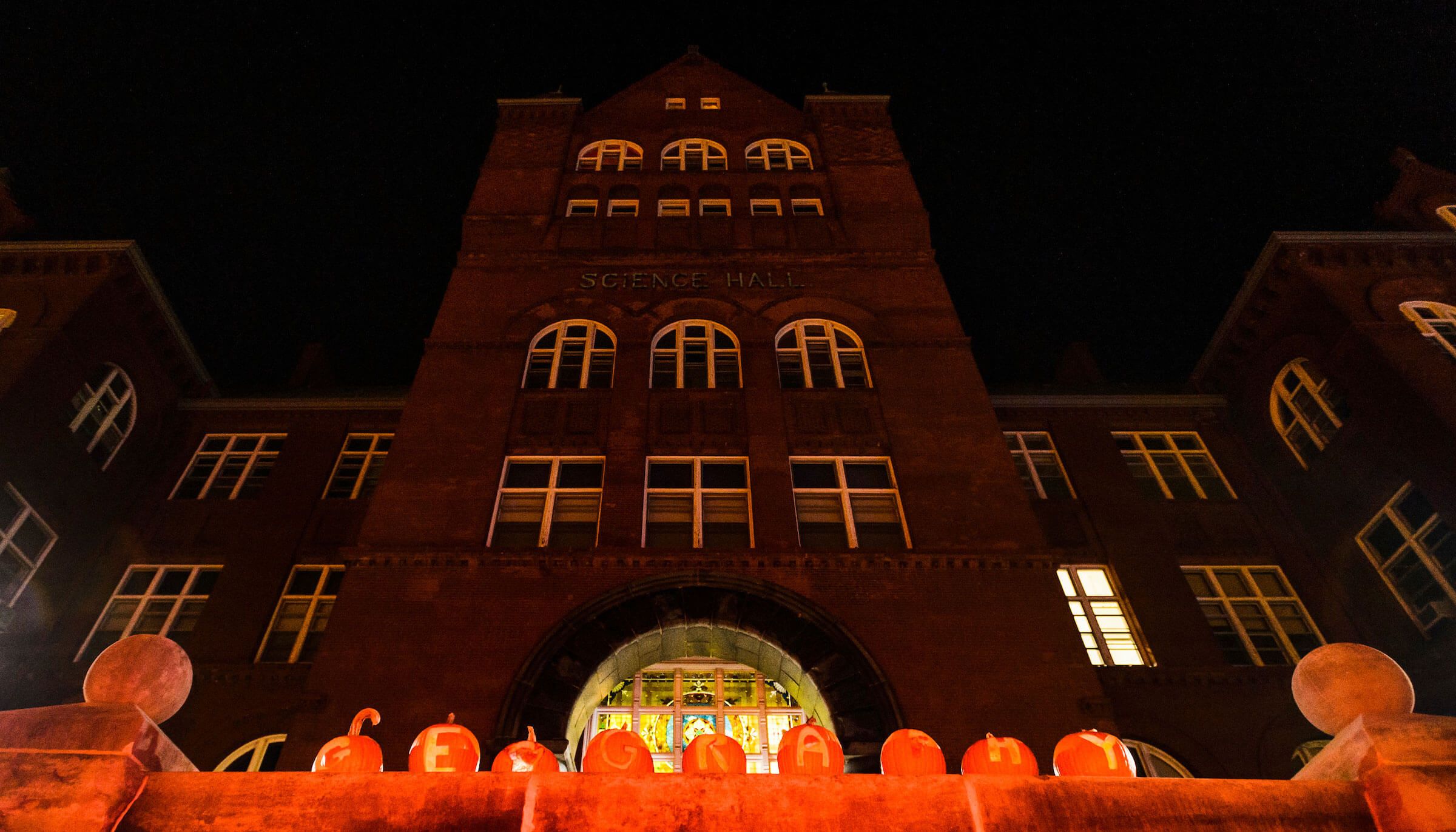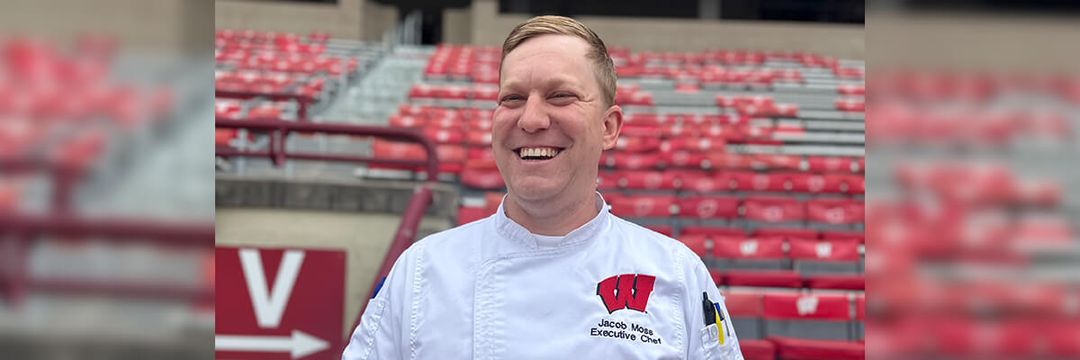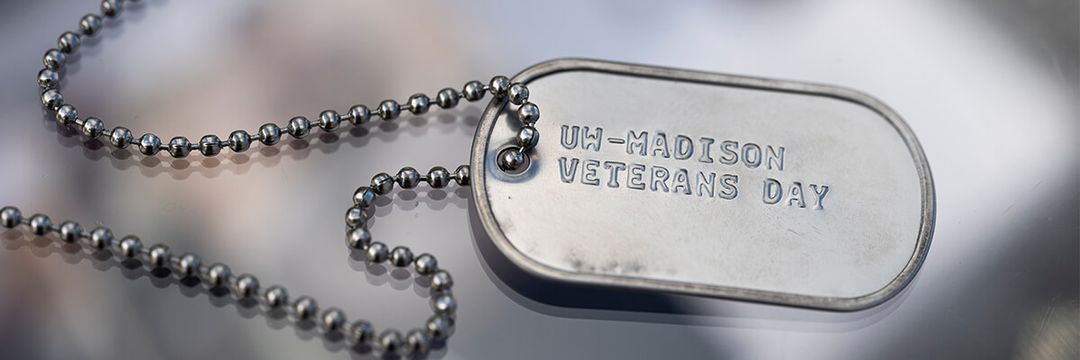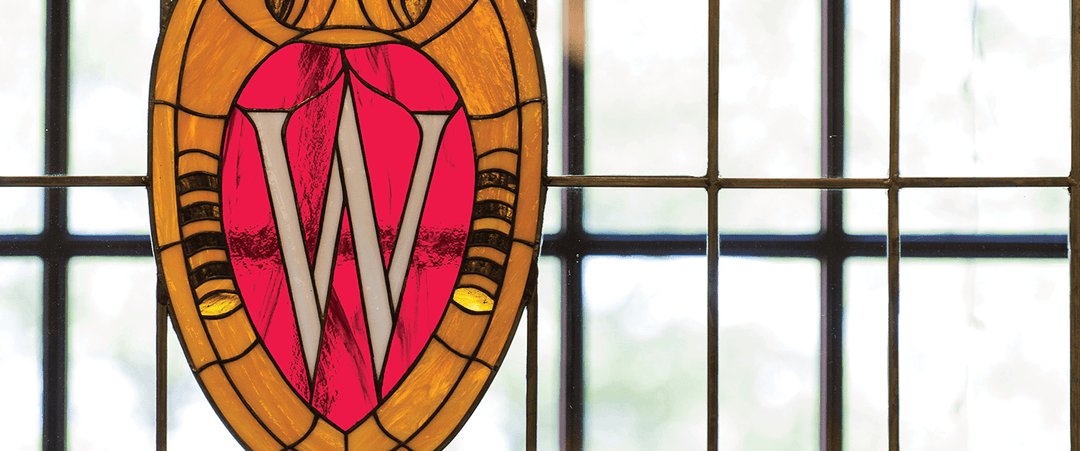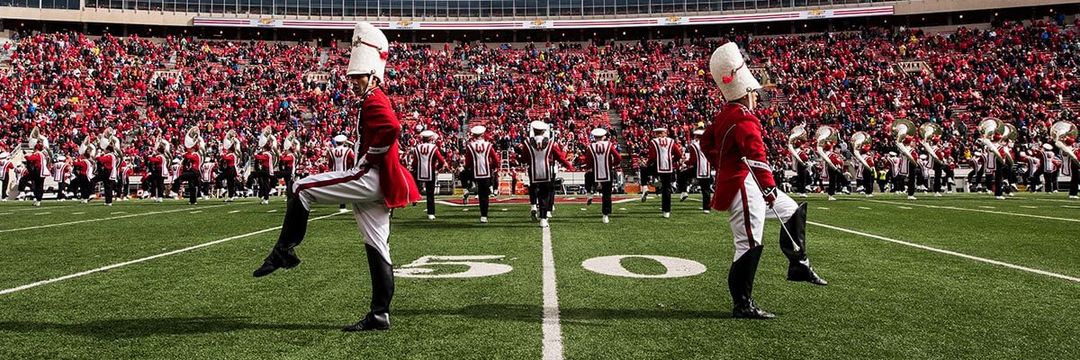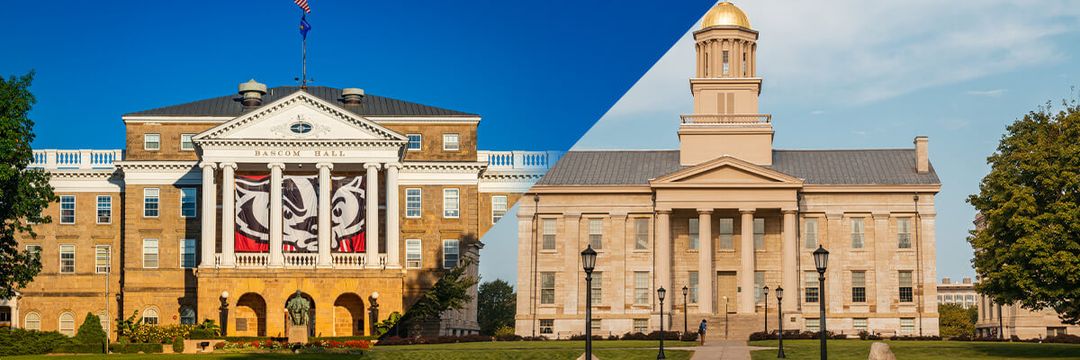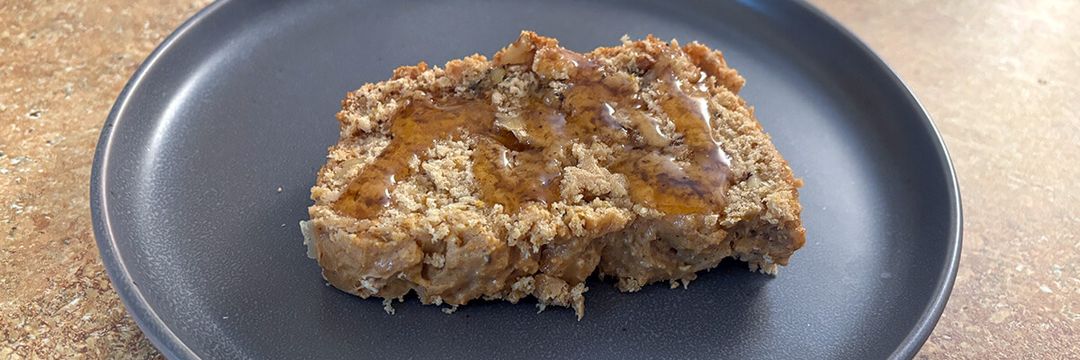Anyone who’s been on campus long enough has heard the tales of the haunting of Science Hall. Some people find these stories entertaining. Some find it offensive to spread paranormal tales about a building dedicated to rational thought. Others couldn’t care less one way or the other.
As for me? I’ve been an amateur ghost hunter for more than 10 years. Though, strictly speaking, it isn’t the ghosts I hunt; it’s ghost stories and their origins. A legend may spark from actual events, social issues of the day, or simple misunderstandings. From there, the story evolves with each new teller and takes on a life of its own. I decided to do some digging and find the truth behind the stories of Science Hall — or at least get as close to the truth as I could.
The Mad Professor
The story goes that, years ago, a crazed professor had a secret lab in the attic of Science Hall where he conducted twisted experiments. Could there be a historical basis for the story? Early floor plans indicate several private laboratories on the lower floors, and a course catalogue from 1888–89 mentions that advanced zoology or botany students could be given “facilities” for “original work,” so it certainly wouldn’t have been unheard of for a student or professor to have a personal space for research. But was the attic one of them?
On a cool, cloudy day, I met with campus geography librarian Tom Tews MA’90 for a tour of Science Hall. Tews has been working there since 1984, so he’s one of the go-to guys for questions about the building. I asked him how often he hears about paranormal activity.
“Never. Only when people come to talk to me about rumors of it being haunted,” he said with a grin in my direction.
I asked him if he’d ever heard anything about a professor having a lab in the attic. To my surprise, he said yes — there was some evidence of a former occupant up there, though well before his time. And he offered to show me.
We took the building’s golden elevator as high as it would go to a small, fifth-floor landing. Tews unlocked a metal gate, and we continued farther up a dim, narrow staircase, ducking to avoid knocking our heads on the sharply slanted ceiling. Then he opened another locked door and flipped on a single, bare lightbulb.
The attic of Science Hall presented a wealth of information out of context: boxes of soil samples from 1978; old panes from the building’s classic, curved windows; leftover building materials; and so on. Undated photographs from the University Archives indicate that this section of the attic was once used as an anatomy classroom, though it was probably a temporary lecture room rather than a lab.
We ventured up a steep ramp toward a small room at the back of the attic, where the darkness melted away. With its east-facing windows, the little room was comfortably bright — even without lights. Here, there was more debris from years gone by: an old Rolodex, library cards, a wooden office chair, boxes and boxes of outdated equipment, and then …
Tews pointed out a long, thin, metal pipe with a series of old valves along one wall. Anyone who has worked in a lab would recognize them: gas valves, such as the sort used for Bunsen burners. One still had an old, rubber tube attached. The pipe ran through two metal supports attached to a cluttered wooden workbench in front of the wall. As Tews said, this made it likely that the bench and pipe were installed at the same time.
But how old was the equipment, and who used it? I took a closer look, hoping for a clue such as “Frankenstein was here” scratched into a cabinet door. No such luck. Most of the valves looked fairly generic, but one on the end of the row caught my eye. It had a decorative flat handle and a fleur-de-lis stamped on the side.
According to antique gas-lighting expert Paul Ivazes, the fleur-de-lis gas valve dates from the mid-1870s to the early 1890s. Since Science Hall was completed in 1887, I figured the attic laboratory must have been an original feature. So, instead of considering the thousands of people who have come and gone throughout Science Hall’s entire history, I had a short list of professors and students who could have used that lab from roughly 1888 to 1894.
All I needed was one piece of evidence to tell me who. Just one. And yet, after hours in the University Archives and countless wild-goose chases, I was at a dead end. Was it Edward Birge, the beloved professor, dean, and university president who practically invented the field of limnology? I can tell you he was a speed reader with a playful sense of humor and the nickname “Dr. Bugs,” but I have no idea if he had a secret lab. Or was it Thomas Chamberlin, one of the greatest geologists in history? He hated administrative work, preferring to hike into the wilderness with his camping gear and a rock hammer. He only agreed to become university president if he could finish his work with the U.S. Geological Survey — but in his list of conditions for accepting the presidency, a private lab isn’t mentioned anywhere.
Then, I found a photo of an antibiotic research lab in the early 1930s. It wasn’t in Science Hall, but the workbenches were the same design as the one in Science Hall’s attic. The photo was likely taken in what eventually became Birge Hall, where the botany department was relocated to after Science Hall ran out of space. While it was an exciting find, this was bad news for my search. It meant that, despite the gas pipes being anchored in the walls, these benches could be — and were — moved and reinstalled in new places over the years. While it’s still possible that the workbench in the attic of Science Hall was original to the building (unless it was retrofitted with an antique gas valve at some point just to confuse future historians), we can’t be certain that it was always in its present location. Which puts us back at square one, with thousands of potential candidates who may have occupied the space.
So, was there ever a mad professor in the attic? The answer remains a resounding: “I don’t know.” For now.
What I do know is that after weeks of reading through their papers, Birge, Chamberlin, and others like them are more than names on campus buildings and streets to me now. Having peeked into their lives, I find myself thinking of them as friends, and I smile a little when I walk past the places where they once lived and worked. The people may be gone, but the places live on.
Footsteps Behind You
It’s one of the most common stories about Science Hall: people who have worked or studied there reporting strange sounds where there shouldn’t have been any. And it may not have been their imaginations.
Early writings about Science Hall make a big deal of its ventilation system. People were extremely proud of its massive steam pipes, intake vents, and so on. As it turns out, that system is also exceptional at conveying sound. It’s not unusual to pass by the central staircase and suddenly hear people on the floor above as though they were just down the hall. Tews mentioned that, on more than one occasion, he thought there was a bird trapped in the room with him, only to realize that said bird was likely in an air vent elsewhere. Furthermore, Science Hall is more than 130 years old — and like all old things, it has its creaks and groans. These are carried through the ventilation system as well. If you’re in the building at a particularly quiet hour, in a room where nothing should be creaking, those sounds can be unsettling.
The Spirit of Science Hall
Science Hall is a fascinating case. Most of its lore is more or less verifiable — but when you whittle away the dramatic flourishes and misunderstandings, you’ll find that none of the more common stories involve actually seeing a ghost. Not even the classic “lady in white,” who is reputed to haunt everything from castles to taxis. It seems that the real heart of Science Hall’s “haunting” is the feeling it evokes. The strange or gruesome parts of its history only seem to be retold in an attempt to explain why it feels that way.
Jay Scholz, IT and facility manager in Science Hall, frequently works alone “at all odd hours … at midnight, sometimes,” but said he’s “never seen anything weird.” However, he had his own hypothesis about why some people find the place odd.
“We do have some weird building anomalies,” he pointed out, such as half-sized doors that lead to crawlspaces and the appropriately nicknamed “Door to Nowhere” halfway between the third and fourth floors. He suggested it’s these “architectural mysteries” that contribute to the building’s reputation. Anyone who is familiar with the supposedly haunted Winchester Mystery House in California will see the similarities. But are peculiarities like these enough to make it haunted?
When you talk to people who work in Science Hall about its little quirks, the response is almost universal. They shrug and say, “What do you expect? It’s Science Hall,” with a tone that is equal parts resignation and awe.
It’s Science Hall.
It’s clear that means so much more than the name of the building. It means a place that’s loved and cherished, even when mice scurry through offices or when drain pipes clog with 130 years of hard-water buildup. Just as you can walk into a theater and tingle with the feeling that something exciting is about to happen, Science Hall hums with promise. It’s a place where people pour out their passion and curiosity for the world, and where human understanding of our planet and ourselves has been — and continues to be — reshaped countless times. It’s a place with character. Its murmurs and worn edges are badges of distinction that it has earned over the multiple lifetimes of its inhabitants. Whether you believe it to be haunted or not, Science Hall certainly has a spirit.
Special thanks to John Allen, Tom Tews, Daniel Einstein MS’95, Jaime Martindale, Brenda Hemstead, Jay Scholz, Katie Nash, and the rest of the staff of the University Archives for their research assistance.
VIGNETTES
Bodies in the Walls
It sounds like something out of a horror novel: a construction crew breaks down a wall in Science Hall and discovers an entire corpse bricked up inside.
The story, like a good amontillado, has gotten darker with time. The truth is far less dramatic. Years ago, the UW’s anatomy department occupied the upper floors of Science Hall. After it moved out in 1957, some of their study specimens were accidentally left behind in storage. From time to time, someone finds one. The tales of these findings are retold year after year, becoming urban legends such as “The Foot” and “The Tall Man Bones.”
But what really happened? Jon Kimerling MS’73, PhD’76, now professor emeritus of geography at Oregon State University, was one of five cartography students who were cleaning and painting room 470 of Science Hall on August 13, 1974. They noticed a hatch leading to the attic, and Kimerling crawled inside to check it out. He saw something in the dark that he thought might be a dead chicken. As it turned out, it was an embalmed human foot: skin and all, including about five inches of ankle.
In the Madison Capital Times, Kimerling said that they “thought it was gross and ugly, but were not horrified.” Eventually, the foot was returned to the dean of the medical school (Kimerling remembers carrying it across campus in a rubber galosh for safekeeping) and that was the last he heard of it.
Then there are the “tall man” leg bones, supposedly discovered in a wall by a construction crew. But they weren’t walled up at all. According to Science Hall: The First Century by Clarence Olmstead, the infamous event occurred in the early 1970s in a fourth-floor attic. Shirley Paley, the geography department’s administrative secretary at the time, was searching for storage space when she found them. The bones were moved several times and mislaid again until the mid-1980s when they turned up in room 443 as it was being cleaned out for renovation. The fact that the bones were found during a construction project seems to have been misunderstood in retellings, leading to the idea that they were sealed inside the walls.
The Cadaver Chute
In the early days of the anatomy department, study cadavers would be delivered to the morgue in Science Hall’s sub-basement. They were hauled up to the dissection labs via a winch lift — like a dumbwaiter — in the north tower. Allegedly, after students finished working on a cadaver, they would dispose of it by sending it down a giant slide. In the 1970s, students would sneak in at night to ride down the slide, oblivious to its macabre purpose.
True, there was a four-story spiral tube slide in the south rear tower of Science Hall. However, it was a fire escape — the top of which was actually located in Kimerling’s first graduate office. Everyone in his class had “at least one thrilling ride to the bottom.” (And yes, they knew it was a fire escape, not a body chute.) Unfortunately for the mischievous child in all of us, both the slide and the winch lift were replaced with staircases decades ago.
An Unseen Hand
The story goes that on the fourth floor, where the dissection labs used to be, beakers will fall off the shelves one at a time, as though pushed by an invisible force. Ultimately, I couldn’t find a single person who had witnessed this for themselves — and it’s no wonder why. Since 1974, the only scientific departments that still occupy Science Hall are the geography and cartography departments, which are not known for their beaker use. So, either the ghost has a very specific preference for beakers, or this story falls flat.
But where did the story come from? I tracked down a paranormal activity website dating back to 1998. The beaker story first appeared in their index sometime in late 2002. This index, which anyone could contribute to, claimed that the event had been “reported numerous times.” It also claimed that the fourth floor of Science Hall is used primarily for storage and that “not many people go up there,” despite the fourth floor being home to several classrooms and offices. Most likely, whoever contributed this story hadn’t spent time in Science Hall — and yet, this site appears to be the origin point for several others that repeat the tale.
In ghost hunting, as in life, it’s important to check your sources.
